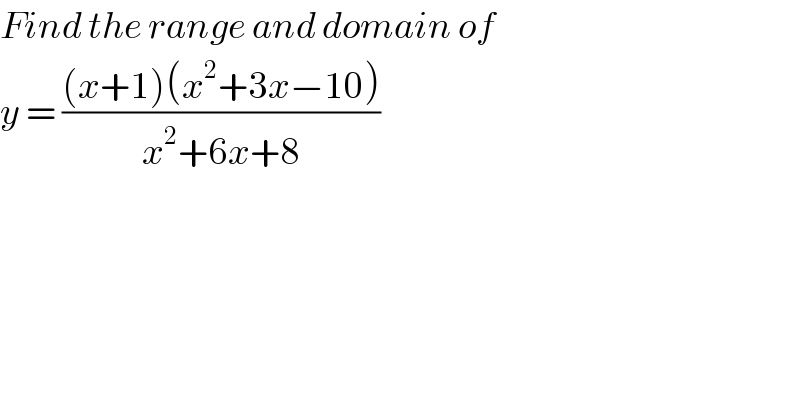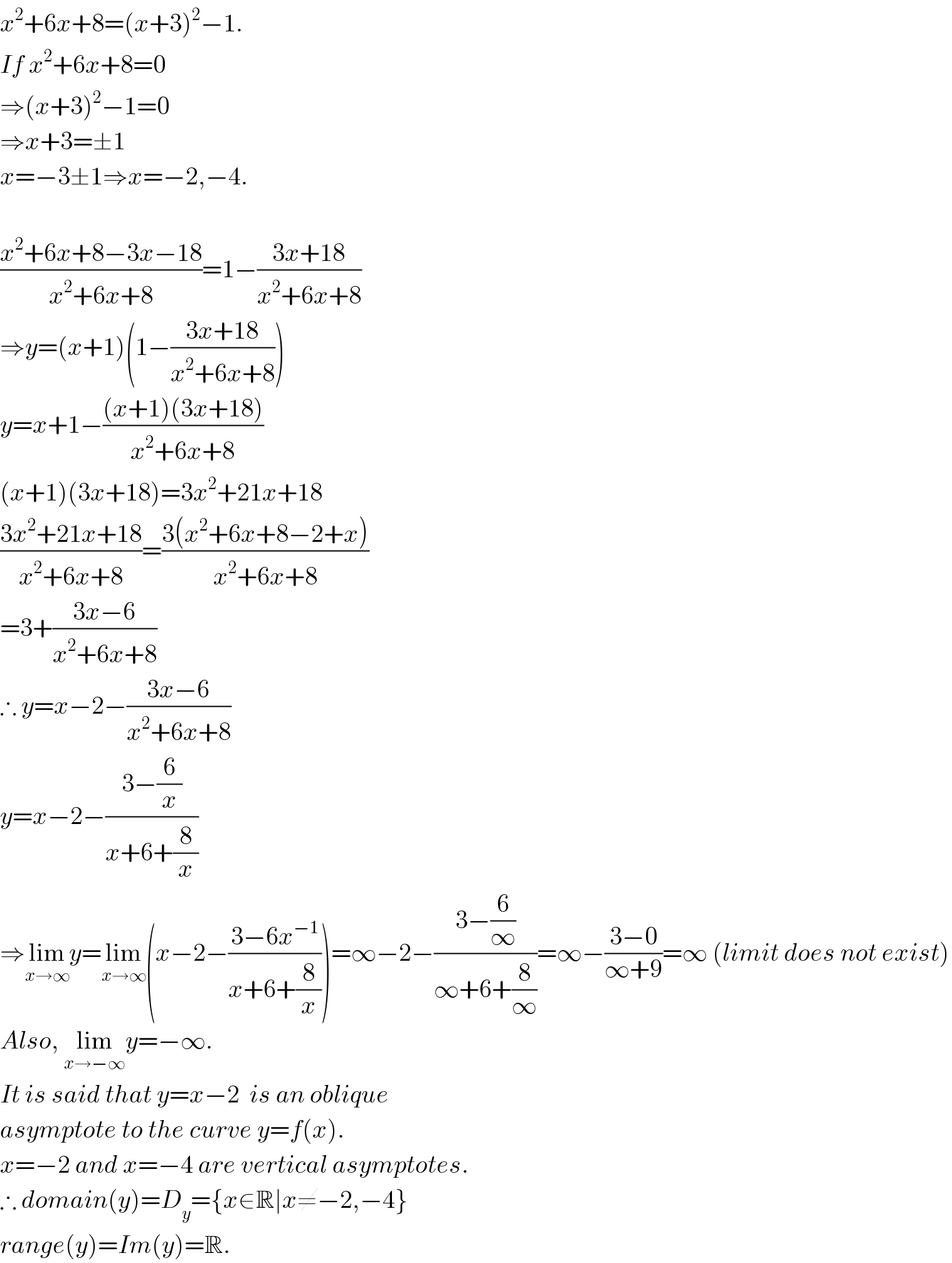
Previous in Relation and Functions Next in Relation and Functions
Question Number 5235 by sanusihammed last updated on 02/May/16

$${Find}\:{the}\:{range}\:{and}\:{domain}\:{of}\: \\ $$$${y}\:=\:\frac{\left({x}+\mathrm{1}\right)\left({x}^{\mathrm{2}} +\mathrm{3}{x}−\mathrm{10}\right)}{{x}^{\mathrm{2}} +\mathrm{6}{x}+\mathrm{8}} \\ $$
Answered by Yozzii last updated on 02/May/16

$${x}^{\mathrm{2}} +\mathrm{6}{x}+\mathrm{8}=\left({x}+\mathrm{3}\right)^{\mathrm{2}} −\mathrm{1}. \\ $$$${If}\:{x}^{\mathrm{2}} +\mathrm{6}{x}+\mathrm{8}=\mathrm{0} \\ $$$$\Rightarrow\left({x}+\mathrm{3}\right)^{\mathrm{2}} −\mathrm{1}=\mathrm{0} \\ $$$$\Rightarrow{x}+\mathrm{3}=\pm\mathrm{1} \\ $$$${x}=−\mathrm{3}\pm\mathrm{1}\Rightarrow{x}=−\mathrm{2},−\mathrm{4}. \\ $$$$ \\ $$$$\frac{{x}^{\mathrm{2}} +\mathrm{6}{x}+\mathrm{8}−\mathrm{3}{x}−\mathrm{18}}{{x}^{\mathrm{2}} +\mathrm{6}{x}+\mathrm{8}}=\mathrm{1}−\frac{\mathrm{3}{x}+\mathrm{18}}{{x}^{\mathrm{2}} +\mathrm{6}{x}+\mathrm{8}} \\ $$$$\Rightarrow{y}=\left({x}+\mathrm{1}\right)\left(\mathrm{1}−\frac{\mathrm{3}{x}+\mathrm{18}}{{x}^{\mathrm{2}} +\mathrm{6}{x}+\mathrm{8}}\right) \\ $$$${y}={x}+\mathrm{1}−\frac{\left({x}+\mathrm{1}\right)\left(\mathrm{3}{x}+\mathrm{18}\right)}{{x}^{\mathrm{2}} +\mathrm{6}{x}+\mathrm{8}} \\ $$$$\left({x}+\mathrm{1}\right)\left(\mathrm{3}{x}+\mathrm{18}\right)=\mathrm{3}{x}^{\mathrm{2}} +\mathrm{21}{x}+\mathrm{18} \\ $$$$\frac{\mathrm{3}{x}^{\mathrm{2}} +\mathrm{21}{x}+\mathrm{18}}{{x}^{\mathrm{2}} +\mathrm{6}{x}+\mathrm{8}}=\frac{\mathrm{3}\left({x}^{\mathrm{2}} +\mathrm{6}{x}+\mathrm{8}−\mathrm{2}+{x}\right)}{{x}^{\mathrm{2}} +\mathrm{6}{x}+\mathrm{8}} \\ $$$$=\mathrm{3}+\frac{\mathrm{3}{x}−\mathrm{6}}{{x}^{\mathrm{2}} +\mathrm{6}{x}+\mathrm{8}} \\ $$$$\therefore\:{y}={x}−\mathrm{2}−\frac{\mathrm{3}{x}−\mathrm{6}}{{x}^{\mathrm{2}} +\mathrm{6}{x}+\mathrm{8}} \\ $$$${y}={x}−\mathrm{2}−\frac{\mathrm{3}−\frac{\mathrm{6}}{{x}}}{{x}+\mathrm{6}+\frac{\mathrm{8}}{{x}}} \\ $$$$\Rightarrow\underset{{x}\rightarrow\infty} {\mathrm{lim}}{y}=\underset{{x}\rightarrow\infty} {\mathrm{lim}}\left({x}−\mathrm{2}−\frac{\mathrm{3}−\mathrm{6}{x}^{−\mathrm{1}} }{{x}+\mathrm{6}+\frac{\mathrm{8}}{{x}}}\right)=\infty−\mathrm{2}−\frac{\mathrm{3}−\frac{\mathrm{6}}{\infty}}{\infty+\mathrm{6}+\frac{\mathrm{8}}{\infty}}=\infty−\frac{\mathrm{3}−\mathrm{0}}{\infty+\mathrm{9}}=\infty\:\left({limit}\:{does}\:{not}\:{exist}\right) \\ $$$${Also},\:\underset{{x}\rightarrow−\infty} {\mathrm{lim}}{y}=−\infty.\: \\ $$$${It}\:{is}\:{said}\:{that}\:{y}={x}−\mathrm{2}\:\:{is}\:{an}\:{oblique} \\ $$$${asymptote}\:{to}\:{the}\:{curve}\:{y}={f}\left({x}\right). \\ $$$${x}=−\mathrm{2}\:{and}\:{x}=−\mathrm{4}\:{are}\:{vertical}\:{asymptotes}. \\ $$$$\therefore\:{domain}\left({y}\right)={D}_{{y}} =\left\{{x}\in\mathbb{R}\mid{x}\neq−\mathrm{2},−\mathrm{4}\right\} \\ $$$${range}\left({y}\right)={Im}\left({y}\right)=\mathbb{R}. \\ $$
